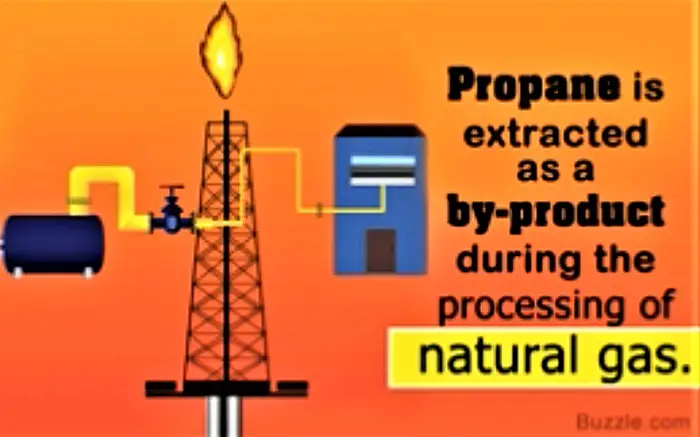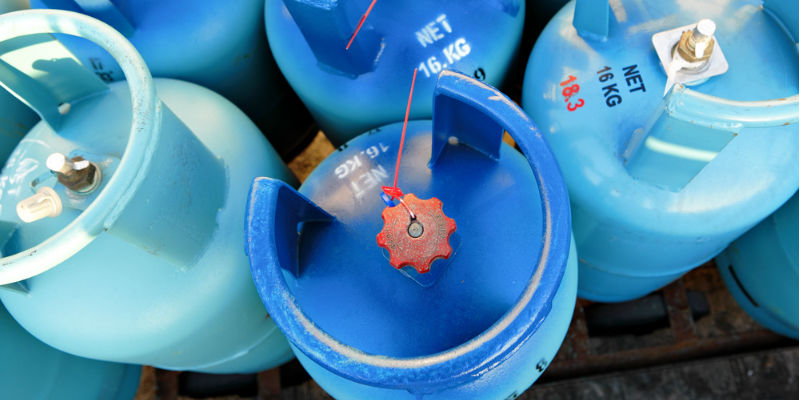Note: This article may contain affiliate links, which means if you make a purchase following our links won’t cost you extra, but we may earn a commission. Learn more
Propane is made from natural gas by a process called fractional distillation. This process involves heating the natural gas to a very high temperature and then cooling it very quickly. The different molecules in the gas condense at different temperatures, and propane is one of the molecules that condense at a relatively low temperature.
Propane Vs Natural Gas
There are many differences between propane and natural gas, but the two most important ones are their energy content and cost. Propane contains about twice as much energy as natural gas per cubic foot, so it is more efficient to use. However, propane costs about twice as much as natural gas per gallon, so it can be more expensive to operate a propane appliance.
Where is Propane Made?
Propane is a hydrocarbon gas that is produced as a by-product of natural gas processing and petroleum refining. It is typically stored as a liquid in pressurized tanks. Propane is widely used as fuel for engines, furnaces, and portable grills.
Propane is made through a process called fractional distillation. This process separates different types of hydrocarbons from each other based on their boiling point. Propane has a relatively low boiling point, so it is among the first gases to be separated during this process.
Most propane in the United States comes from natural gas processing plants in Texas, Louisiana, and Wyoming. However, some propane is also imported from Canada and Mexico.

How is Natural Gas Made?
Natural gas is a fossil fuel that forms when layers of dead plants and animals are buried under sand, soil, and rock and subjected to intense heat and pressure over millions of years. The energy from the decay of these organic materials is converted into methane gas. This process typically occurs deep underground.
Methane is the main component of natural gas. Natural gas deposits are found in many parts of the world, but they are not evenly distributed. The largest reserves are in Russia, Iran, Qatar, Saudi Arabia, and the United States.
Natural gas can be extracted from the ground through drilling. Once natural gas is extracted, it must undergo a process called “sweetening” to remove impurities such as sulfur compounds. After sweetening, natural gas is transported via pipelines to storage facilities or directly to consumers.
Natural gas is a versatile fuel that can be used for heating, cooking, generating electricity, and powering vehicles. When burned, natural gas produces lower emissions than other fossil fuels such as coal and oil.
Related Post: Can a Vertical Propane Tank Be Used Horizontally?
What is LP Gas (Propane) and How is it Made
Natural gas is one of the most abundant resources on Earth, and it’s also a major source of energy. In fact, natural gas is the main ingredient in propane. Propane is a hydrocarbon, which means it’s made up of hydrogen and carbon atoms.
Natural gas is mostly methane, which is made up of one carbon atom and four hydrogen atoms. To make propane, manufacturers remove some of the hydrogen atoms from the methane molecules in natural gas. This process is called “cracking,” and it results in a mixture of ethane and propane molecules.
The propane molecules are then separated from the ethane molecules through a process called “distillation.” Finally, the propane is purified and stored in tanks for use as fuel. Propane has many uses, including powering furnaces, grills, and generators.
It’s also used as an industrial feedstock for making plastics and other chemicals.
How Does Propane Affect the Environment?
Propane is a type of liquefied petroleum gas (LPG) that is commonly used as a fuel source. It is colorless, odorless, and non-toxic. However, when propane is released into the environment, it can have harmful effects.
The most significant environmental concern with propane is its contribution to climate change. Propane is a greenhouse gas, which means that it traps heat in the atmosphere and contributes to global warming. In addition, propane combustion emits other pollutants into the air, including carbon dioxide (CO2), nitrogen oxides (NOx), and sulfur dioxide (SO2).
These pollutants can lead to smog and acid rain, which can damage ecosystems. Another environmental concern with propane is its impact on water resources. Propane extraction and production can pollute water sources with chemicals and waste products.
In addition, leaks from propane tanks or pipelines can contaminate drinking water supplies. Finally, when propane is burned as a fuel, it releases CO2 into the atmosphere, which dissolves in water and creates acidic conditions that can damage aquatic ecosystems.
Is Propane Man Made?
Yes, propane is man-made. It is a by-product of natural gas processing and petroleum refining. Propane is typically stored as a liquid in pressurized tanks.

Credit: www.budgetpropaneontario.com
How Do You Extract Propane from Natural Gas?
Propane is a byproduct of natural gas processing and oil refining. To extract propane from natural gas, the gas is cooled to -48°C (-55°F). This condenses the propane and other light hydrocarbons, which are then separated from the methane.
Propane can also be extracted from crude oil. In this process, the crude oil is heated to 400-700°C (750-1300°F). This causes the lighter hydrocarbons, including propane, to vaporize and be drawn off.
The propane is then condensed and separated from the other gases.
What Percentage of Propane is Processed from Natural Gas?
According to the Propane Education & Research Council, about 90% of propane is processed from natural gas. The other 10% comes from refining crude oil.Propane is a byproduct of both natural gas processing and petroleum refining.
When natural gas is processed for pipeline transportation or storage, some of it is converted to propane. A small amount of propane—less than 3 percent—is also produced when crude oil is refined.
Is Propane Created Naturally?
Propane is a hydrocarbon gas that is derived from the processing of natural gas and crude oil. It is classified as a liquefied petroleum gas (LPG) and is used as fuel for heating, cooking, hot water, and vehicles. Propane is also used as a chemical feedstock in the production of plastics and other industrial products.
The majority of propane produced in the United States is extracted from natural gas processing plants. Crude oil refineries also produce small amounts of propane as a by-product of gasoline and diesel fuel production. A very small amount of propane is derived from biomass sources, such as landfill gas or anaerobic digestion.
Propane occurs naturally in underground reservoirs, associated with petroleum deposits. It is formed during the process of decomposition of organic matter under conditions of high pressure and temperature (a process known as catagenesis). The release of propane from these reservoirs can be triggered by changes in barometric pressure or earthquakes.
How is Propane Produced?
Propane is produced from either natural gas or crude oil. The majority of propane found in the United States is produced from natural gas. In order to extract propane from natural gas, the gas must first be cooled to -42 degrees Fahrenheit.
This process is called fractional distillation and it separates the various gases that make up natural gas by their boiling point. Propane has a boiling point of -44 degrees Fahrenheit, so it is one of the last gases to be extracted during this process. Once the natural gas has been cooled and the propane has been extracted, it is compressed into a liquid form for storage and transportation.
Propane is stored and transported in tanks that are pressurized with nitrogen. This prevents the propane from being exposed to oxygen, which can cause it to combust. So, in summary, propane is produced from either natural gas or crude oil via fractional distillation at -42 degrees Fahrenheit.
It is then compressed into a liquid form for storage and transport in tanks pressurized with nitrogen.
Conclusion
Propane is a three-carbon alkane with the chemical formula C3H8. It is a gas at standard temperature and pressure, but it can be liquefied by compression into a liquid or by cooling to very low temperatures. Propane is derived from either natural gas processing or petroleum refining.
In general, propane from natural gas processing is about 90% pure and propane from refining is about 99% pure.